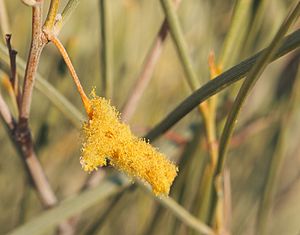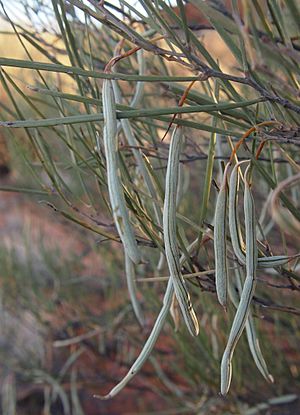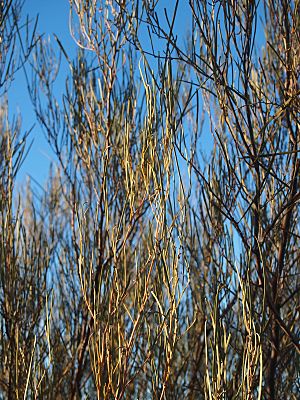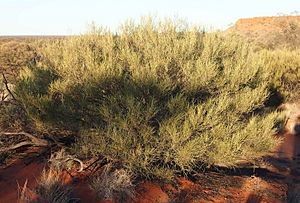Horse mulga facts for kids
Quick facts for kids Horse mulga |
|
|---|---|
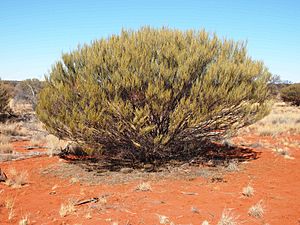 |
|
| A. ramulosa habit | |
| Scientific classification | |
| Genus: |
Acacia
|
| Species: |
ramulosa
|
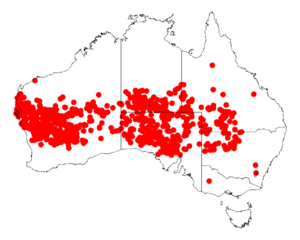 |
|
| Occurrence data from AVH | |
The Acacia ramulosa, often called horse mulga or bowgada wattle, is a type of shrub. It belongs to the Acacia plant family. This plant grows naturally only in the dry, desert-like parts of Australia.
Contents
What Does Horse Mulga Look Like?
The horse mulga is a shrub that stands upright and spreads out. It has many branches. It usually grows to be about 1.5 to 6 meters (5 to 20 feet) tall.
Branches and Leaves
Its branches have small ridges and tiny white hairs. The very tips of the young branches are sticky and darker in color. The leaves of the horse mulga are not typical flat leaves. Instead, they are like flattened leaf stems, called phyllodes. These phyllodes are thick, straight, and long. They are usually about 7 to 15 centimeters (3 to 6 inches) long and 5.5 to 7 millimeters (0.2 to 0.3 inches) wide. They have thick lines running along them.
Flowers and Seed Pods
This plant can bloom at different times of the year, but it often flowers when the weather is cooler or after it rains. Its flowers are yellow and grow in dense, spike-like clusters. These flower spikes are usually 5 to 30 millimeters (0.2 to 1.2 inches) long.
After the flowers, long, straight seed pods grow. These pods are shaped like cylinders and are pointed at both ends. They can be up to 13.5 centimeters (5.3 inches) long and 8 to 10 millimeters (0.3 to 0.4 inches) wide. The pods hang down from the branches, often in groups. They look a bit like a horse's tail, which is how the plant got its common name! The pods are grey with brown stripes. Inside, the seeds are creamy white, oblong, and about 6 to 12 millimeters (0.2 to 0.5 inches) long.
How Horse Mulga Was Named
The first time the horse mulga was officially described was in 1904. A botanist named William Vincent Fitzgerald collected a sample of the plant in 1903. He then wrote about it in a scientific paper. Later, in 1987, another botanist named Leslie Pedley changed its scientific name. But in 2001, it was changed back to Acacia ramulosa.
The name ramulosa comes from a Latin word. It means "many branchlets," which describes how the shrub has lots of small branches.
Different Types and Hybrids
There are two main types, or "variants," of Acacia ramulosa: Acacia ramulosa var. linophylla and Acacia ramulosa var. ramulosa.
Sometimes, different types of Acacia plants can mix their genes. This creates a new plant called a hybrid. Horse mulga can form hybrids with other Acacia species, like Acacia aneura. These hybrids are sometimes called Acacia brachystachya or Acacia cibaria. It can also mix with Acacia craspedocarpa and Acacia coolgardiensis.
Where Horse Mulga Grows
The horse mulga grows across a large part of dry Australia. You can find it in southern Queensland, western New South Wales, the southern Northern Territory, and parts of South Australia. It also grows in the Goldfields and Mid West areas of Western Australia.
It usually grows in red sandy soils or sandy loamy soils, especially in low areas between sand dunes. It can also be found on shallow, stony soils where there are laterite rocks. In some parts of its range, it forms large groups of plants.
Its Home in the Woodland
The horse mulga is an important part of the Mulga woodland areas. It often grows alongside other plants like Acacia aneura, Acacia pruinocarpa, Acacia quadrimarginea, and Eucalyptus loxophleba. You might also see it with different grasses and shrubs like Casuarina cristata and Corymbia opaca.
Uses of Horse Mulga
This plant is good for planting in gardens, especially in coastal areas or on sandy plains. It can also provide a home for wildlife. It grows well in full sun or partial shade. It prefers sandy or loamy soils that are not too acidic.
The horse mulga is a tough plant! It can handle dry weather (drought), salty soil, and even salt spray from the ocean. It can also survive bushfires.
Traditional Food Source
Long ago, Indigenous Australians used the seeds of the horse mulga as a food source. They prepared the seeds in different ways. The young, green pods could be eaten raw or cooked by roasting or steaming them. The dry, mature seeds were ground into a flour. This flour was then mixed with water to make a paste, or it could be cooked like a type of bread called damper.


